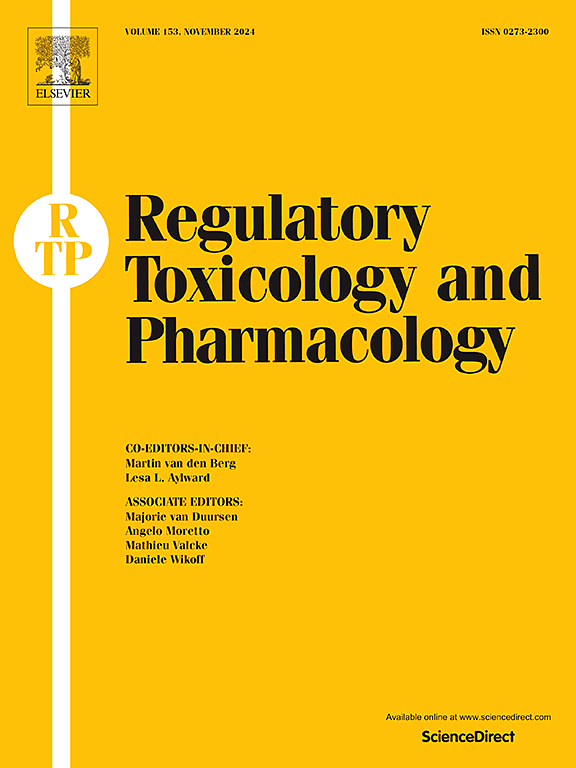Preliminary safety risk assessment of parabens in children's cosmetics sold in China
IF 3.5
4区 医学
Q1 MEDICINE, LEGAL
引用次数: 0
Abstract
Since adverse health outcomes of parabens added in children's cosmetics have been reported, it is important to investigate preliminary risk characteristic assessment of parabens preservatives in children's cosmetics. This study aimed to calculate exposure parameters using a combination experimental data and an exposure assessment tool to make safety assessment for parabens in children's cosmetics. The paraben concentration of different formulation types of 63 products of children's cosmetic products were measured by High Performance Liquid Chromatography. Based on product usage, paraben concentrations, exposure factors, behavioral patterns and exposure routes, the exposure parameters of parabens in children's cosmetics were calculated by mathematical mode from ConsExpo Web. A margin of safety (MoS) was calculated for safety evaluations. Results showed that 4-hydroxybenzoate methyl (MP) was the most commonly used paraben, which was used in 30.2 % of products, followed by propyl 4-hydroxybenzoate (PP) (12.7 %), ethyl 4-hydroxybenzoate (EP) and butyl 4-hydroxybenzoate (BP) both in 1.6 % of products. The concentrations of parabens in the cosmetic products were all within the safety limits required by the SCCS. The exposure to parabens decreased with increasing age in accordance with a published data. The MoS of parabens in children's cosmetics were all more than 100, indicating parabens to be of manageable risk and safe for use.
对羟基苯甲酸酯在中国销售的儿童化妆品中的初步安全风险评估
由于儿童化妆品中添加的对羟基苯甲酸酯对健康的不良影响已经有报道,因此对儿童化妆品中添加的对羟基苯甲酸酯防腐剂进行初步的风险特征评估是很重要的。本研究旨在结合实验数据和暴露评估工具计算暴露参数,对羟基苯甲酸酯在儿童化妆品中的安全性进行评估。采用高效液相色谱法测定了63种儿童化妆品中不同剂型对羟基苯甲酸酯的浓度。根据产品使用情况、对羟基苯甲酸酯浓度、暴露因素、行为模式和暴露途径,利用ConsExpo网站上的数学模型计算儿童化妆品中对羟基苯甲酸酯的暴露参数。计算安全边际(MoS)进行安全评价。结果表明,4-羟基苯甲酸甲酯(MP)是最常用的对羟基苯甲酸酯,占30.2%,其次是4-羟基苯甲酸丙酯(PP)(12.7%), 4-羟基苯甲酸乙酯(EP)和4-羟基苯甲酸丁酯(BP),均占1.6%。化妆品中对羟基苯甲酸酯的浓度均在SCCS要求的安全范围内。根据公布的数据,对羟基苯甲酸酯的暴露随着年龄的增长而减少。对羟基苯甲酸酯在儿童化妆品中的最大含量都在100以上,表明对羟基苯甲酸酯具有可控的风险,可以安全使用。
本文章由计算机程序翻译,如有差异,请以英文原文为准。
求助全文
约1分钟内获得全文
求助全文
来源期刊
CiteScore
6.70
自引率
8.80%
发文量
147
审稿时长
58 days
期刊介绍:
Regulatory Toxicology and Pharmacology publishes peer reviewed articles that involve the generation, evaluation, and interpretation of experimental animal and human data that are of direct importance and relevance for regulatory authorities with respect to toxicological and pharmacological regulations in society. All peer-reviewed articles that are published should be devoted to improve the protection of human health and environment. Reviews and discussions are welcomed that address legal and/or regulatory decisions with respect to risk assessment and management of toxicological and pharmacological compounds on a scientific basis. It addresses an international readership of scientists, risk assessors and managers, and other professionals active in the field of human and environmental health.
Types of peer-reviewed articles published:
-Original research articles of relevance for regulatory aspects covering aspects including, but not limited to:
1.Factors influencing human sensitivity
2.Exposure science related to risk assessment
3.Alternative toxicological test methods
4.Frameworks for evaluation and integration of data in regulatory evaluations
5.Harmonization across regulatory agencies
6.Read-across methods and evaluations
-Contemporary Reviews on policy related Research issues
-Letters to the Editor
-Guest Editorials (by Invitation)

 求助内容:
求助内容: 应助结果提醒方式:
应助结果提醒方式:


